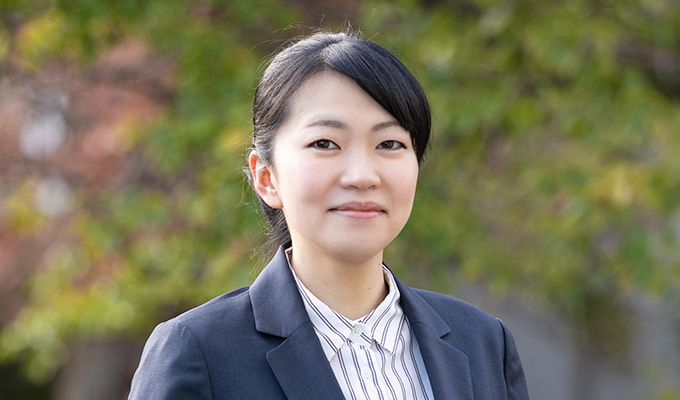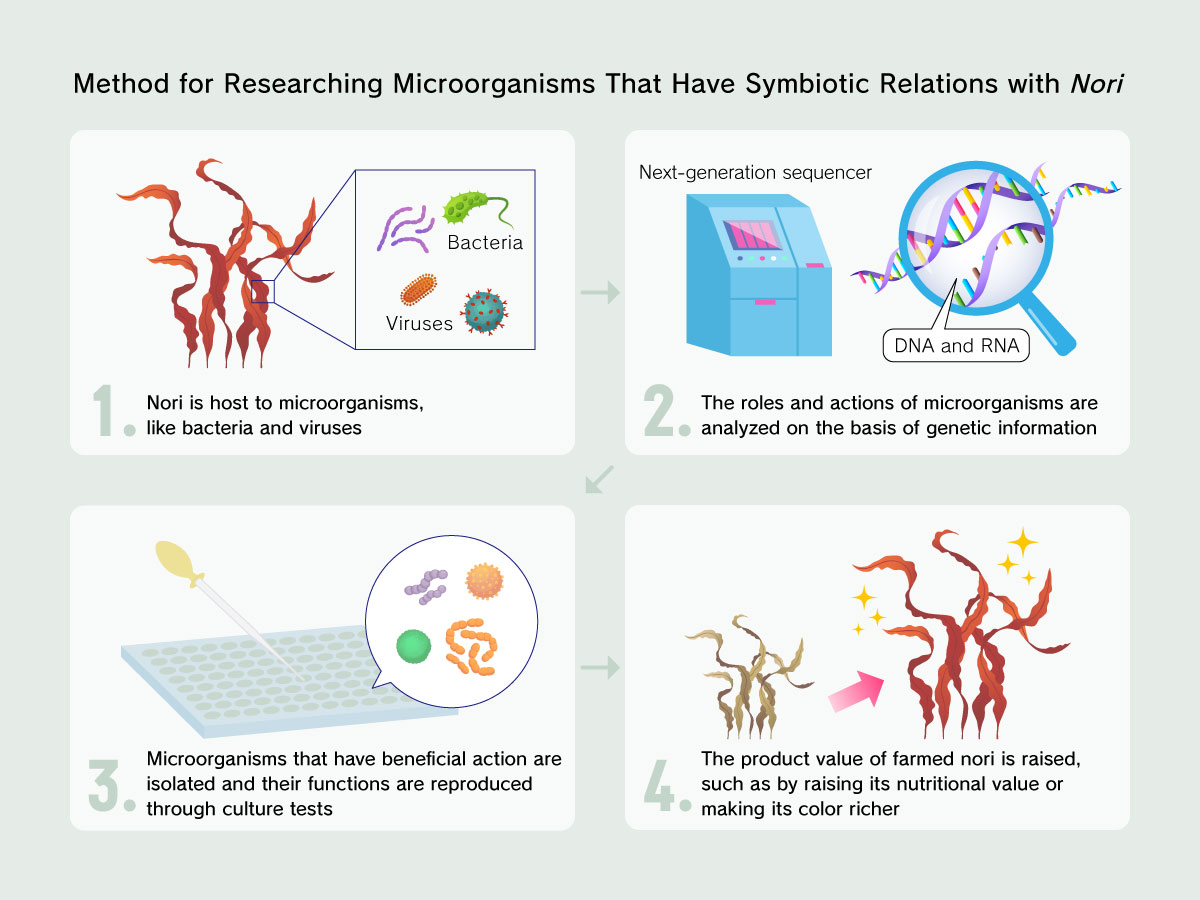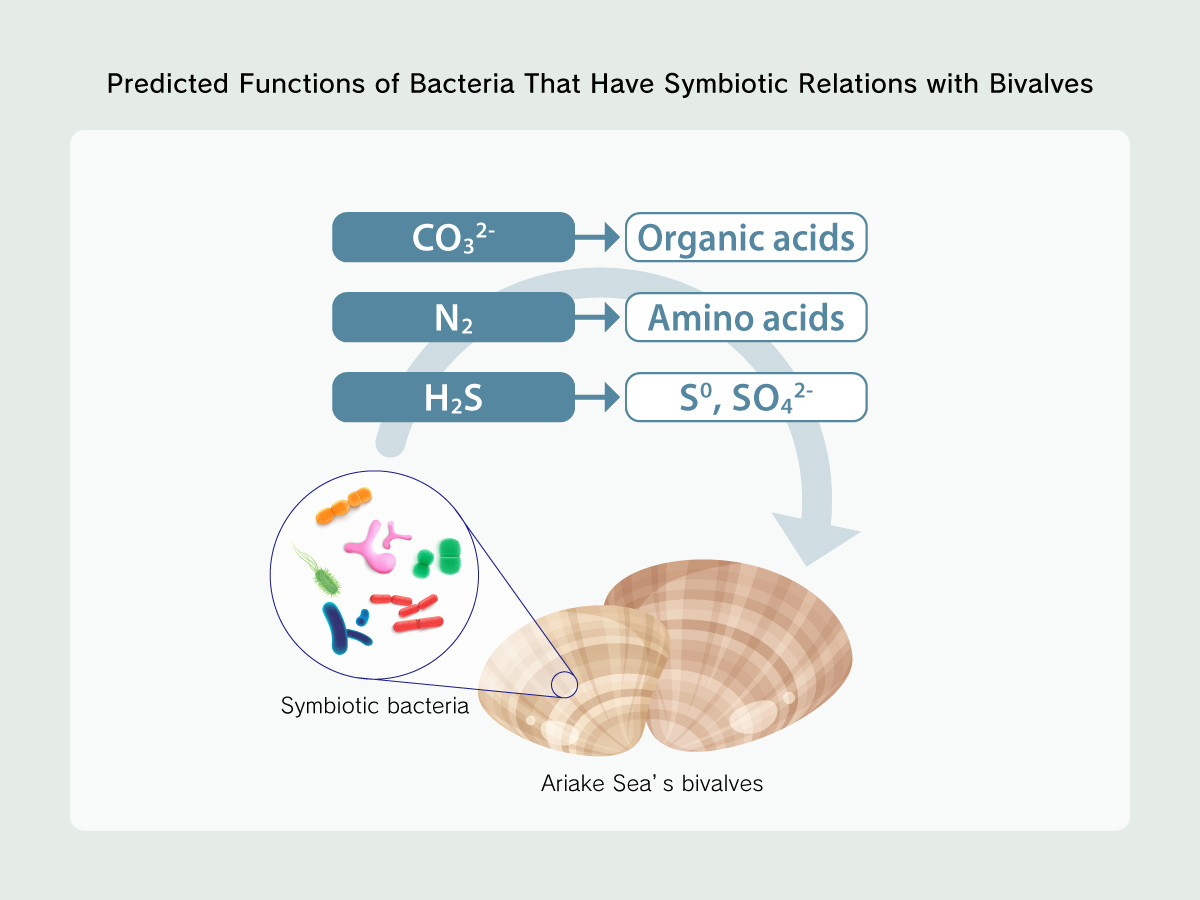Search for microorganisms that co-exit with organisms in the Ariake Sea and illumination of their functions

Research Fields
Marine microbiology, molecular biology, phycology
Keywords
Microorganisms, nori seaweed, bivalves, interactions, genome analyses
Research overview
Working to Aid Local Industries by Illuminating and Reproducing the Mysteries of the Ariake Sea’s Organisms Researching the Bacteria and Viruses of the Ariake Sea’s Organisms
I have been studying bacteria that have symbiotic relations with bivalves since I was a university student. I am currently searching for microorganisms that co-exist with organisms that inhabit the Ariake Sea and illuminating their functions. I am directing my attention in particular to nori (edible seaweed) and bivalves, which are foodstuffs.
■ Discovery of New Viruses Present in Nori
To search for microscopic organisms on/inside nori and bivalves, I have collected the DNA or RNA storing genetic information that these microorganisms possess and have analyzed what kind of bacteria and viruses are present.
I consequently discovered that several species of bacteria with the same functions have settled on the nori and that these bacteria have genes for synthesizing vitamins, plant hormones, and other valuable substances. A newly discovered Mitovirus is present in all nori of the Ariake Sea, regardless of whether the nori is of the raw and still unprocessed variety or it is of the dried variety that we usually eat. Because the viruses that are classified as mitoviruses possess the attribute of replicating through vertical transmission from parent to offspring, this recently discovered virus is suggested to live inside the cells of the host nori for a long time, and it may be affecting the nori in some ways and creating a symbiotic relationship. I surmise that it may be possible to raise nori’s nutritional value, deepen its color, and elevate the product value of cultivated nori in other ways by analyzing the actions of these bacteria and viruses, selecting the microorganisms that have beneficial activities through culture tests, and reproducing the analyzed functions.
I am continuing my research into bivalves because I suspect that, among the bacteria that live in certain bivalves, there are those with metabolic functions that detoxify hydrogen sulfide, which is harmful to bivalves.
■ Making Full Use of an Environment Conducive to Research, and Giving Back to the Community
At Saga University, research has been conducted on the Ariake Sea. I can say that the research environment here is very conducive to studies because I can do research while exchanging information on not only living organisms but also on the preservation of the environment, culture, and multiple other fronts. In addition, the University’s Analytical Research Center for Experimental Sciences to which I belong has many specialized facilities, and the full use of these has been extremely important in the continuance of my research.
While I leverage this learning environment, I intend to further illuminate and reproduce the relationships between the microorganisms and their hosts that are peculiar to the Ariake Sea and apply the knowledge to the aquaculture industry.
Message
Due to advances in technology, mystifying organisms are being continuously discovered through genetic information. Even so, the world of biology is one in which many mysteries remain. In particular, the Ariake Sea is an environment that offers up many new discoveries. It is home to organisms that are not seen elsewhere in Japan. Join us, and let us together illuminate the mysteries of Ariake Sea’s organisms.
Main publications
- Yukino Mizutani, Tetsushi Mori, Taeko Miyazaki, Satoshi Fukuzaki, Reiji Tanaka. Microbial community analysis in the gills of abalones suggested possible dominance of epsilonproteobacterium in Haliotis gigantea. PeerJ. 8:e9326 2020.
- Yukino Mizutani, Shunpei Iehata, Tetsushi Mori, Ryota Oh, Satoshi Fukuzaki, Reiji Tanaka. Diversity, enumeration and isolation of Arcobacter spp. in the giant abalone, Haliotis gigantea. MicrobiologyOpen. 8:e890. DOI: 10.1002/mbo3.890. 2019.
- Yukino Mizutani, Reiji Tanaka. Genome Sequence of Arcobacter sp. strain LA11, isolated from the abalone Haliotis discus. Genome Announc. DOI: 10.1128/genomeA. 00032-17. 2017.
- Reiji Tanaka, Ilse Cleenwerck, Yukino Mizutani, Shunpei Iehata, Peter Bossier, Peter Vandamme. Arcobacter haliotis sp. nov., isolated from abalone species Haliotis gigantea. Int J Syst Evol Microbiol. 67:3050-3056. 2017.
- Reiji Tanaka, Yukino Mizutani, Toshiyuki Shibata, Hideo Miyake, Shunpei Iehata, Tetsushi Mori, Kouichi Kuroda, Mitsuyoshi Ueda. Genome sequence of Formosa haliotis strain MA1, a brown alga-degrading bacterium isolated from the gut of abalone Haliotis gigantea. Genome Announc. 4: e01312-16. 2016.





